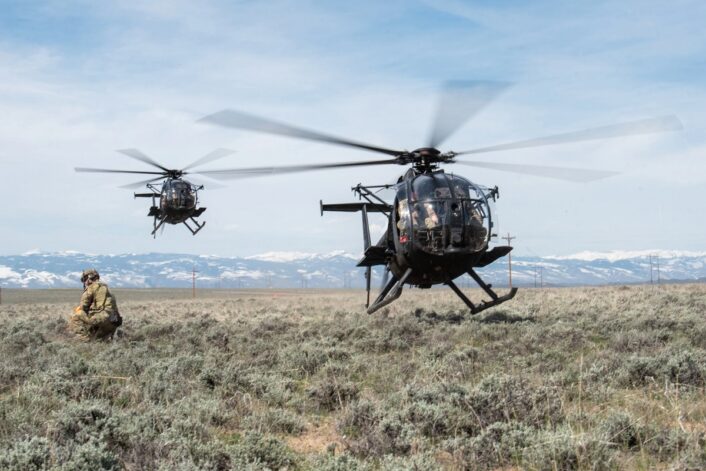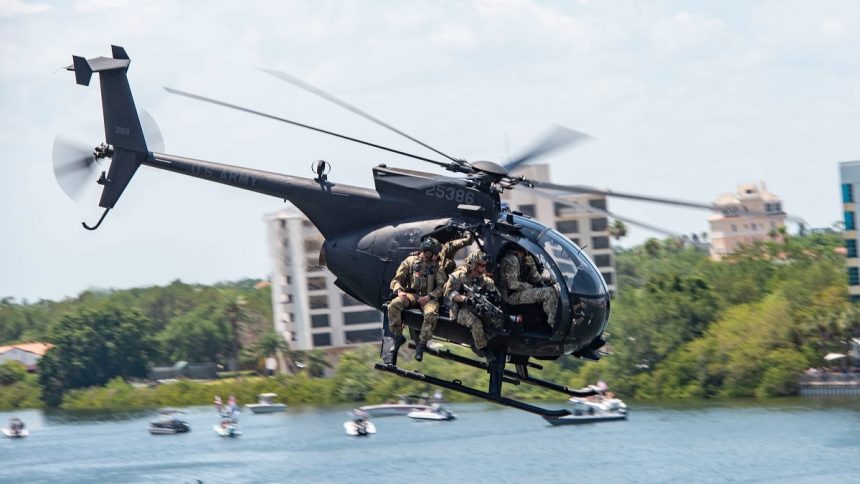As the Future Attack Reconnaissance Aircraft was cancelled earlier this year, the Little Bird is set to continue playing an important role in the 160th SOAR for the foreseeable future.
The A/MH-6 Little Bird, one of the most notorious helicopters of the U.S. Special Operations Command, might have to wait a few more years before enjoying its deserved retirement. In fact, after the cancellation of the Future Attack Reconnaissance Aircraft program earlier this year, SOCOM is now reassessing its options.
The winning design from the FARA competition was expected to also replace the Little Bird, in addition to the already replaced OH-58 Kiowa Warrior. The replacement was also supposed to remedy to the A/MH-6’s longstanding problem, its limited speed, which won’t allow it to keep up with the increasing speed of current and future U.S. helicopters.
“That changed our equation because that was going to become the armed platform that was going to take the role of the AH-6 [Little Bird] and would take the role of the [MH-60 Black Hawk] DAP [Direct Action Penetrator],” said Dr. Steven Smith, SOCOM’s Program Executive Officer for Rotary Wing aviation programs, during the recent Special Operations Forces Week conference.
The 160th Special Operations Aviation Regiment (Airborne) “Night Stalkers”, the highly specialized combat aviation unit which supports U.S. and coalition special operations forces, is the only unit in the Army using the A/MH-6. The “Night Stalkers” operate a variety of assets, including the MH-47G Chinooks, MH-60L/M/K Black Hawks and A/MH-6M Little Birds.
The current M variant of the Little Bird is currently being upgraded to the Block III configuration, which this year was renamed as A/MH-6R and its delivery next year will be now even more important. “With the cancellation of FARA that R is not a Romeo, I’m calling it ‘Little Bird Resurrection.’ So it’s the future for Little Bird,” said Smith.
The A/MH-6 Little Bird
The H-6 family first flew in 1963 following a requirement for a Light Observation Helicopter (LOH) that could perform personnel transport, escort and attack missions, casualty evacuation, and observation. First designated OH-6, the helicopter has been widely used since the Vietnam conflict as special operations and observation/light attack helicopters.
After Operation Eagle Claw in 1980 it was decided to create a special aviation taskforce with aircraft and crews who were trained and prepared to perform special operations missions, called Task Force 160 (which later evolved in the current 160th SOAR). Soon, the task force identified the need for a small helicopter that could land in the most restrictive locations and could be easily transported on U.S. Air Force airlifters.
The choice fell on the OH-6A, which became known as the Little Bird and was later modified in the two variants AH-6 and MH-6. The 160th SOAR is now equipped with both MH-6 transport variant and AH-6 attack variant of the Little Bird, which took part in almost all major U.S. operations since the 1980s.
Specifically, both variants have a “common core” which can be easily converted from one variant to the other. The AH-6 is equipped with specially designed stub wings that can carry M134 7.62 mm miniguns, GAU-19 .50 cal gatling guns, 70 mm rockets and AGM-114 Hellfire missiles, while the MH-6 is equipped with special planks for special operators and a Fast Rope Insertion Extraction System (FRIES) kit.
Although it has been continuously updated, the H-6 is now a legacy platform and the aging airframes are now approaching the end of their structural lifespan. That’s where the Block III/H-6R upgrade comes into play.
The A/MH-6R upgrade
The current Block 2.2 mod of the A/MH-6M variants recently integrated new tactical radios and Forward Looking Infrared Sensor, as well as a new plank with an integrated pintle-arm mount for an M-240 7.62mm machine gun. The new Block III upgrade, which has been formally designated as A/MH-6R, includes even more changes, drastically extending the useful life of the helicopter.
In fact, the biggest upgrade in the larger Block III is a new zero-time fuselage, built by Boeing, which will have a predicted life of 15 years and raises the gross weight limit to 5,000 lb, up from the previous 4,700 lb. The new fuselage incorporates all the previous structural modifications that were applied to the H-6 platform, while building in an increased safety margin.

In addition to this, the helicopter will get a major cockpit facelift, with a new Avionics Management System, which includes primary flight display, flight management and moving map, and an Advanced Airborne Tactical Mission Suite, which includes an Improved Electro Optical Sensor, Situational Awareness improvements and an update of the communication suite.
The new R variant will continue to be upgraded, with potential work involving powertrain, advanced rotor blades and mission systems. The plan is to keep the A/MH-6R flying at least until 2034 while the U.S. SOCOM looks for a replacement.









